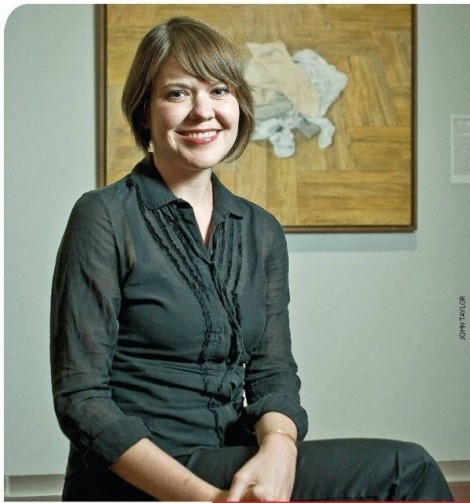
There’s a new girl in town. Well, relatively
speaking.
Although she has been in Salt
Lake City for more than a year, Jill Dawsey—
curator of modern and contemporary art at
the Utah Museum of Fine Arts—is now beginning
to assert her presence in the local art
world. Having studied and worked at various
pre-eminent institutions such as Stanford
University, San Francisco Museum of Modern
Art, The Whitney, The National Gallery of Art
and many others, Dawsey has an acute sensibility
for art and art history and a refreshing
objective to expose Utah to world-class contemporary
and emerging artists.
Being in a new city, with a very different
and more isolated art scene, and in a
new position—in fact, her job title didn’t
exist before she was hired—she was understandably
a bit disoriented, and it took
some adjustment. And now, after a period
of acclimation, Dawsey is using her keen,
young expertise to introduce the state
to her modern and contemporary taste.
“Museums in general are moving towards
showing more contemporary art,” she says,
“[and I would like] to show work of emerging
artists—what’s happening right now.”
Just what does this new position entail?
In addition to curating special exhibitions,
overseeing and reinvigorating the
permanent collection, proposing new
acquisitions and playing a lead role in the
UMFA Young Benefactors group, Dawsey
is working with fellow curators to, as she
puts it, “re-envision the museum for what
it is.” UMFA is not just a contemporary
art museum but also a teaching institution
whose role is to tell the story of art
from ancient times to the present moment.
After examining the collection and audience,
Dawsey says, two main emphases
have come into focus: Utah/Western art
and contemporary art.
It is imperative that the intersection of local and global achieves a balance. Many locals would favor the former, but the museum’s slogan declares itself “Utah’s Passport to the World” and, in keeping with this sentiment, it must also maintain an international agenda. It’s extremely important, Dawsey believes, for artists especially to be aware of art from all over.
One of the concepts she hopes to implement
by summer 2010 is a project space
for global exposure and emerging artists.
“I want to put us on the map. I want UMFA
to be in [a publication like] Art Forum
because of what we show,” she says.
Access to important work will help to
strengthen the arts program; another
endeavor the museum is working on is
finding ways to better serve the university
community.
This does not mean Dawsey intends to leave local creations high and dry. Although “Western art” can call to mind bad cowboy art reproductions and wrought-iron-fence adornments, the West—Utah in particular—holds much regional-historical import. After all, the Great Salt Lake is home to perhaps the single most important earthwork in modern art, Robert Smithson’s “Spiral Jetty.”
In fact, Smithson’s impact on artists
is something Dawsey hopes to explore
in a future show. “There are too few
institutions of cultural memory as it is,”
she says, and she plans on working with
UMFA Western/Utah art curator Donna
Poulton to put together affective regional
exhibitions.
Desert Secrets, a contemporary photo
exhibit focused on the strangeness of
Western landscapes, is next on the docket,
opening on July 9 (see Desert Secrets). A series of provocative, content-related
films will accompany the show.
Dawsey has also been freshening up
the permanent collection. In addition to
digging up some gems—rare Ann Truitt
paintings on paper and some noteworthy
paintings and drawings by Smithson—and
reintroducing them into the rotation, she
is also responsible for some exciting loans
and acquisitions, the most prized—and
pricey, in the midst of a recession—being
a Carl Andre sculpture she recently added
to the collection. (The funding for the
piece was destined; Phyllis Wattis, one
of the most charitable art patrons and
cultural enablers of the west—and one of
Brigham Young’s great-granddaughters—
who donated extensively to San Francisco
Museum of Modern Art, left an endowment
specifically for the acquisition of modern
art at UMFA.) “Baghdad Screen Tests,” on
special loan from artist Phil Collins—one
of Dawsey’s favorite current artists—is
a video piece she is particularly excited
about displaying in the context of the permanent
collection.
Dawsey’s influence is already detectable
in Then & Now: Selections from the Permanent
Collection of Modern and Contemporary Art,
currently on view at UMFA. It’s a fresh look
at a long-standing collection, just as her
arrival will prove a new take on the region.
Her academic, curatorial, teaching, writing
and lecturing repertoire has taken her
to many major art institutions. Now Salt
Lake City has her at its disposal to offer
new insight at UMFA.